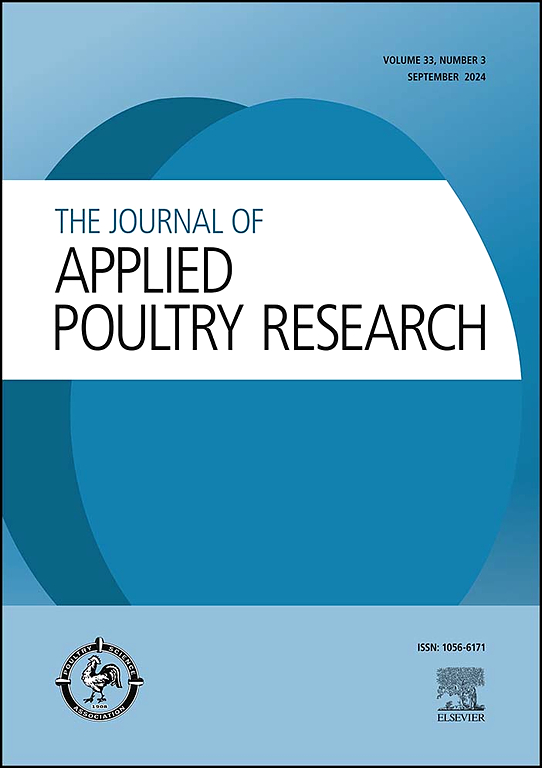Evaluation of the effects of maintaining a moderate humidity (50–60%) and increased air movement on litter moisture and footpad health in a commercial broiler house
IF 1.6
3区 农林科学
Q2 AGRICULTURE, DAIRY & ANIMAL SCIENCE
引用次数: 0
Abstract
High litter moisture (>25%) strongly correlates with higher ammonia and increased footpad lesions. Although there are methods to help reduce the occurrence of high litter moisture, such as ventilation and proper drinker management, these methods need to evolve due to increasing consumer demands and more stringent animal welfare guidelines. A potentially cost-effective method may be ventilating houses to maintain a moderate RH level (60% or lower) and increasing the amount of air movement (150 ft/min) over the litter surface through circulation fans. This field study examined the possible effects of this combination on litter moisture and footpad health. The combination (TRT) had the greatest impact during the first 3 wk of a flock. The mean litter moisture was below 25% during this period in TRT houses. While litter moisture in the control (CTL) houses (no circulation fans- same RH) was 30% or greater. During the first 21 d, in 3 out of the 4 study flocks, less than 10% of birds had signs of lesions in the TRT house compared to up to 29% of birds in the CTL house. At the end of the flock, birds in the CTL house had, on average, a 23% higher rate of severe lesions than birds in the TRT house. These findings suggest moderate RH and supplemental air movement over the litter surface (150 ft/min) can benefit litter moisture control and footpad health.
评价维持适度湿度(50-60%)和增加空气流动对商品肉鸡舍产仔水分和脚垫健康的影响
高凋落物水分(25%)与高氨和增加的足部病变密切相关。虽然有一些方法可以帮助减少高凋落物水分的发生,例如通风和适当的饮水者管理,但由于消费者需求的增加和更严格的动物福利准则,这些方法需要不断发展。一种潜在的经济有效的方法可能是给房屋通风,以保持适度的相对湿度水平(60%或更低),并通过循环风扇增加垃圾表面的空气流动量(150英尺/分钟)。本实地研究考察了这种组合对凋落物水分和脚垫健康的可能影响。组合(TRT)对鸡群的前3周影响最大。在此期间,TRT房屋的平均凋落物水分低于25%。而对照组(CTL)房屋(没有循环风机-相同RH)的凋落物水分为30%或更高。在头21天,在4个研究禽群中的3个中,不到10%的鸟在TRT房中有病变迹象,而CTL房中高达29%的鸟有病变迹象。在鸡群结束时,CTL屋的鸟比TRT屋的鸟平均高23%的严重病变率。这些发现表明,适度的相对湿度和在凋落物表面补充空气流动(150英尺/分钟)有利于凋落物水分控制和脚垫健康。
本文章由计算机程序翻译,如有差异,请以英文原文为准。
求助全文
约1分钟内获得全文
求助全文
来源期刊

Journal of Applied Poultry Research
农林科学-奶制品与动物科学
CiteScore
4.10
自引率
10.50%
发文量
80
审稿时长
104 days
期刊介绍:
The Journal of Applied Poultry Research (JAPR) publishes original research reports, field reports, and reviews on breeding, hatching, health and disease, layer management, meat bird processing and products, meat bird management, microbiology, food safety, nutrition, environment, sanitation, welfare, and economics. As of January 2020, JAPR will become an Open Access journal with no subscription charges, meaning authors who publish here can make their research immediately, permanently, and freely accessible worldwide while retaining copyright to their work. Papers submitted for publication after October 1, 2019 will be published as Open Access papers.
The readers of JAPR are in education, extension, industry, and government, including research, teaching, administration, veterinary medicine, management, production, quality assurance, product development, and technical services. Nutritionists, breeder flock supervisors, production managers, microbiologists, laboratory personnel, food safety and sanitation managers, poultry processing managers, feed manufacturers, and egg producers use JAPR to keep up with current applied poultry research.
 求助内容:
求助内容: 应助结果提醒方式:
应助结果提醒方式:


